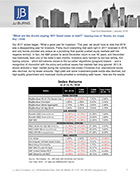It is both delightfully simple and genuinely compelling to be able to summarize the behavior of the equity markets, not only in the last 12 months but over the last two years. I can in fact do it in two sentences:
- In 2022, the Dow, the S&P 500 and the Nasdaq 100 experienced peak-to-trough declines of 21%, 25% and 35%, respectively.
- A week before Christmas 2023, all three were in new high ground on a total return basis (that is, including dividends).
Why stocks did this is irrelevant to the wonderful lessons to be drawn from this experience. There are almost as many theories and explanations of why as there are market commentators, of whom I am happily not one. (I would point out, however, that the number of said commentators who successfully forecast both the market action of 2022 and that of 2023 is, to my knowledge, plus or minus zero.)
What should matter most to us long-term, goal-focused, plan-driven equity investors is not why this happened, but that it happened. Specifically, that there could be a pervasive and very significant bear market over most of one year, and that those declines could be entirely erased in the following year. Although not nearly as quick or as perfectly symmetrical as the 2022-23 experience, in the largest sense that’s how it works.
I’ve broken my market insights into two parts: first the timeless and enduring principles reinforced by these past two years, and then a consideration of current conditions.
General Principles
- The economy can’t be consistently predicted, nor the market consistently timed. Thus we believe that the highest-probability method of capturing equities’ long-term return is simply to remain invested all the time.
- We are long-term owners of businesses, as opposed to speculators on the near-term trend of stock prices.
- Declines in the mainstream equity market, though frequent and sometimes quite significant, have always been surmounted, as America’s most consistently successful companies ceaselessly innovate.
- Long-term investment success most reliably depends on making a plan and acting continuously on that plan.
- An investment policy based on anticipating (or reacting to) current economic, financial or political events/trends most often fails in the long run.
Current Commentary
- We remain convinced that the long-term disruptions and distortions resulting from the COVID pandemic are still working themselves out in the economy, the markets and the society itself, in ways that can’t be predicted, much less rendered into coherent investment policy.
- The central financial event in response to COVID was a 40% explosion in the M2 money supply by the Federal Reserve. It predictably ignited a firestorm of inflation.
- To stamp out that inflation, the Fed then implemented the sharpest, fastest interest rate spike in its 110-year history. Both debt and equity markets cratered in response.
- Despite this, economic activity just about everywhere but in the housing sector has remained relatively robust; employment activity has, at least so far, been largely unaffected.
- Inflation has come down significantly, though not yet close to the Fed’s 2% target. But prices for most goods and nearly all services remain elevated, straining middle-class budgets.
- Capital markets have recovered significantly, as speculation now centers on when and how much the Fed may lower interest rates in 2024, and whether a recession may yet begin, whatever they do. These outcomes are unknowable—probably even to the Fed itself—and don’t lend themselves to forming a rational long-term investment policy.
- Significant uncertainties abound. Trends in the U.S. federal deficit and the national debt continue to appear unsustainable. Social Security and Medicare appear to be on paths to eventual insolvency unless reformed. The serial debt ceiling crisis continues, and a bitterly partisan presidential election looms. The markets will face significant challenges this year—as indeed they do every year.
Our overall recommendations are essentially what they were two years ago at this time, and what they’ve always been.
Let’s continue to revisit your most important long-term financial goals. If those goals haven’t changed, we recommend staying with your current plan. And if your plan isn’t changing, there will most likely be no compelling reason to materially alter your portfolio.
As always, we welcome your questions and comments, and look forward to talking with you soon.
– JJ Burns
Disclosure: J.J. Burns & Company, LLC is a registered investment adviser with the U.S. Securities & Exchange Commission and maintains notice filings with the States of New York, Florida Pennsylvania, New Jersey, Connecticut, Georgia, Illinois, North Carolina, and California. J.J. Burns & Company, LLC only transacts business in states where it is properly registered, or excluded or exempted from registration. Follow-up and individualized responses to persons that involves either the effecting or attempting to effect transactions in securities, or the rendering of personalized investment advice for compensation, as the case may be, will not be made absent compliance with state investment adviser and investment adviser representative registration requirements, or an applicable exemption or exclusion.
All investing involves risk, including the potential for loss of principal. There is no guarantee that any investment plan or strategy will be successful.
The foregoing content reflects the opinions of J.J. Burns & Company, LLC and is subject to change at any time without notice. Content provided herein is for informational purposes only and should not be used or construed as investment advice or a recommendation regarding the purchase or sale of any security. There is no guarantee that the statements, opinions or forecasts provided herein will prove to be correct.
Past performance may not be indicative of future results. Indices are not available for direct investment. Any investor who attempts to mimic the performance of an index would incur fees and expenses which would reduce returns.
Securities investing involves risk, including the potential for loss of principal. There is no assurance that any investment plan or strategy will be successful.


